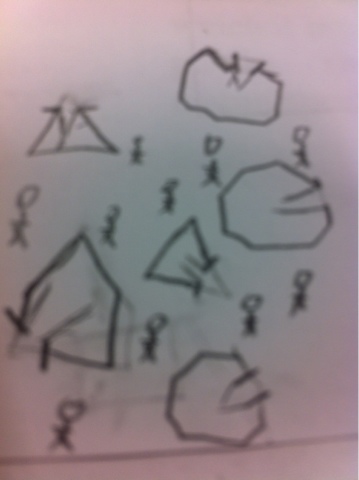Monday, October 7, 2013
Flatland Summary: Chapter 6
This section threw me off pretty hard. Mostly because the narrator likes to tell his stories like a kid in the first grade, bouncing from subject to subject. At first he implied (strongly) that it is difficult to identify individuals. Apparently everyone tells each other just by looking at each other. But it's not that simple either. A man can appear to be a woman at first glance if he does not show his angle. In addition to that, feeling is discouraged umong the youth because it creates bad habits. In short, this story leaves me with more questions than The Dark Knight Rises and just as angry.
Friday, October 4, 2013
Flatland Chapter 3 Summary
Saturday, September 28, 2013
Flatland Summary: Chapter 5
In chapter five we discover that in Flatland, the inhabitants cannot see one another like we do. But there is still discrimination present between social classes and sexes. How does this happen? Those in Flatland have a few methods of distinguishing one another but the most popular are, feeling , the process of feeling each others' angles to determine social class, and looking to see where two lines incline, thus creating an angle. The process of feeling may sound rigorous, but it is taught in schools at a young age. Feeling also requires carefulness, and can prove fatal even by the most seemingly insignificant mistake.
Thursday, September 19, 2013
How to Copy Perpendicular Bisectors
First, measure the original segment with the compass. Second, draw a full, 360* circle for every point on the segment. By now two over lapping circles. In between the two circles, take the compass and draw another segment, in the opposite direction as the first, but still over lapping.
Wednesday, August 28, 2013
Mathography
I never really liked math. It has always been my worst subject. I'm not saying this with intent to sound cynical. Hopefully I don't come across as such. I've always gotten A's and B's with little effort in all my classes, but I always found myself struggling to maintain a B-. It was almost a battle everyday I had Math just so I wouldn't drop to a C+.
Any day I had Algebra seemed like a bad day. My teacher didn't seem to care, along with all the kids in my class. To be honest, at times I found myself not caring also. But I knew if I didn't want this class next year I would have to put away all of my apathy for the next 90 minutes and get things done.
Now that I'm out of Algebra, I hope that this year in Geometry will be way better. I have a class full of people that I like, whether I knew them until I had this class or not, and a teacher who has a very unique approach to teaching math. I always heard people like Geometry more than Algebra, and from what I can tell, I feel that way too.
Flatland Chapter 2 Summary
In chapter two the author discusses the bizarre infrastructure of Flatland. There is no sense of direction, almost in direct correlation to there being no sun. The civilians of Flatland are being oppressed by only being allowed to have a house with five angles with a city of more than 10,000. Rural areas often have square houses though, and triangle buildings are only reserved for government buildings and military.
Wednesday, August 21, 2013
Flatland Chapter One Summary
The story Flatland is told by the shape of a square. Strange, I know. The setting is in Flatland, the name the narrator chose to give his world. In here, he describes a two dimensional world where everything are shapes. There are no shadows, only shapes. If you were to live in Flatland, you would only see lines, but from a bird's eye view you can see a world of shapes.
Subscribe to:
Comments (Atom)






